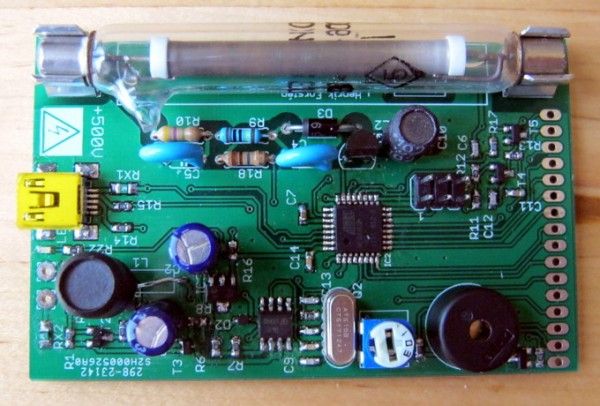Ionizing radiation is something that almost anyone finds exciting (or scary) and I’ve also been for long wanted to build a Geiger counter. Unfortunately Geiger tubes have usually been too expensive to seriously consider buying them just for a hobby project. But I found out that sovtube sold soviet cold war era Geiger tubes only for a couple dollars. I bought one CI-22BG tube and one CI-3BG tube for total of 16€ including shipping from Ukraine to Finland. The site itself didn’t really convince me payment via Paypal failed because of invalid seller email address and gmail warned me that order confirmation e-mail might not have come from the address it claimed. However, I got both of the tubes and they seemed to be okay.
Because I didn’t have anything radioactive to test my Geiger counter, I also ordered a piece of radioactive Fiesta dinnerware from ebay. Red Fiestware used to have uranium oxide in its glaze that was radioactive enough to be detected with a Geiger counter.
Geiger tube needs a high voltage, my tubes need 400V, to function. We need also a microcontroller to count the events and maybe a LCD to display the output. Also no Geiger counter is complete without a buzzer. I decided to also have USB port now that I included a microcontroller.
The device can be powered by USB or external voltage source. Circuit on the upper left corner, which was copied from this Stack Exchange answer, is responsible for choosing the right power supply. It will use USB if it’s connected, otherwise it’ll connect the external power supply. IC1 is step up converter that will increase supply voltage to 7V, or pass it through if it’s already over 7V. This will allow the device to work with even 2V external voltage. IC3 is 5V low dropout regulator, that will regulate 7V to 5V for microcontroller. At the center there’s the high voltage supply that will output 400V from 7V input. It runs in a closed loop with microcontroller adjusting the duty cycle to get a stable output voltage.
Normally Geiger tube will pass only a small leakage current, but when ionizing radiation hits the Geiger tube some of the gas inside the tube is ionized which will allow higher current through the tube, 4.7M anode resistor R10 limits this current to a safe value. This current will raise voltage at the base of T4 turning it on which pulls the detect net low. Then the microcontroller interrupts at the pin change and counts one event.
High voltage supply schematic. R18, R19 and C13 are for feedback to microcontroller. R9 and C5 are used to filter the output and R10 is Geiger tubes anode resistor.
Because I wanted the device to work with USB the input voltage is 5V and this needs to be raised to 400V. Many other Geiger counter high voltage supplies use some topology that includes a transformer, but because transformers are big, heavy and expensive I didn’t want to use them. At first I wondered if ordinary boost DC/DC converter running in discontinuous mode would give high enough voltage gain, so I made some test on a breadboard and with right components I managed to get 444V from 5V input voltage, which is more than enough to drive a Geiger tube. It could have gone to even higher voltages, but I was already over the SF16 diodes 400V breakdown voltage and 450V was upper limit of Geiger tubes working voltage. With a better layout on the PCB output voltage can reach over 500V.
For more detail: DIY Geiger counter

